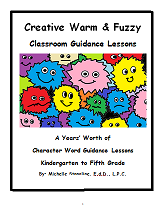Sand Tray Therapy Midterm--Video Critiques Student #2
Sandplay / Sand Tray therapy Video Critiques
1. www.sandtraytherapyinstitute.com
I thought that Steve Armstrong did an excellent job of teaching about sandtray therapy. His explanation of getting started as well as the uses and advantages of sandtray therapy over traditional talk therapy showed how valuable it can be and stirred up excitement in me at the possibility of using it to facilitate growth and change in others, especially those who have experienced grief or trauma. It will be interesting for me to learn the humanistic approach of staying in the “here and now” and steering toward exploration instead of interpretation. Also, the videos taught me the importance of addressing feelings. It was fascinating for me to see how the sandtray stirred up emotions for Steve Armstrong’s wife but how he stayed calm and reassuring. I appreciated his suggestions that sandtray therapy should only be used if trust has been established between the client and therapist and that if a person is having difficulty coping then it should not be used. I am interested to learn more about these ideas.
2. Sandplay Therapy with Barbara Turner
Barbara’s passion and over 20 years’ experience with sandplay was very apparent as I watched this video. I thought she did an excellent job of presenting how to introduce sandplay to both children and adults. It was helpful for her to give the history of sandplay in order to better explain Jungian concepts of personality theory and the concept that people have a natural tendency to grow, develop, and heal. It was also interesting to see how learning theory is used as the client and therapist work together. The client sees and feels through their sandtray, and the therapist helps to make it real through validation. I was particularly fascinated by the research from neurobiologists that physical healing in the right hemisphere and limbic functions of the brain is also taking place through sandtray therapy. As she explained the sandplay therapy process and presented the vignettes, did not completely understand how the psyche moved to “manifestation of the self” then returned to an “ordinary world” but I can see the benefit of accessing the unconscious mind and the mutuality of the relationship between the client and the therapist. I found it fascinating to see Barbara create her own tray and see the unconscious mind at work. I must admit, however, that I was left feeling a bit scared after watching as she explained the seriousness and potential for “evoking a psychotic process” when a therapist is not extensively trained.
3. Sand Play Counseling Session for Training (Jill Weadick)
As I watched this video, I noticed that the client spent most of her time staring at the sandtray and not looking at the therapist. I could see how this would be helpful to the client so that she could stay focused on her “world” and not get distracted or feel self-conscious. I liked how the therapist used the same words that the client used when she was asking her about placing the miniatures at certain places and she said “it had to be.” I thought the follow-up question asking how it is to “have to be so many things” was perfect. However, as the video progressed, it was irritating for me to hear the therapist keep repeating exactly what the client said. It sounded like parroting to me. If I were the client, that may have bothered me. It was interesting to see the client move some of the miniatures to help her to feel better. The sand tray obviously stirred up sadness for the client at the end when she began to cry. However, I was confused whether that was part of her thoughts about the child abuse or something else. I expected the therapist to ask her about what was happening to cause the sadness but she didn’t. At the end, the therapist said that the sandtray therapy session should change one’s heart and soul. Unfortunately, I really didn’t feel that.
4. Adult Therapy in Sandtray (Jill Weadick)
This video was powerful. It was a great example of how sandplay can be used along with talk therapy to help clients understand themselves. I believe that allowing the client the opportunity to choose the miniatures that represented her husband and herself then allow herself to explain the relationship taught the client a great deal about herself. It was interesting to see her choose the two-faced man to represent her husband—someone she could trust only half the time. Then, it was amazing to see her choose the young girl doll to show how inferior she feels in relation to her husband then pick up the miniature and stick it down into the sand with head down. Being “stuck” described perfectly how she was feeling. I believe it took giving the client the opportunity to create a 3-D picture to see clearly how she felt and help her better process the decision she needed to make about staying in the marriage. This clearly demonstrated how the therapy process can be sped up using sandtray.
5. Jill Weadick’s Videos
Jill did an excellent job of introducing sandplay by explaining how the size of a sand tray is perfect for one’s peripheral vision and how sandplay gets people back in touch with nature and the earth and feeling more grounded. Watching her 4-year-old daughter was fun. I can see how children under 5 years old would not be cognitively developed enough to benefit from sandplay. I like her explanation of how to arrange figurines for sandplay. It was fascinating to see the sandtray from the adolescent who was cutting and how she covered the dragon over the course of the session. In that video, however, I do not think Jill did an adequate job of explaining how the girl was healed or who the figures represented and would have liked to hear more analysis. I really appreciated Jill’s sand healing journal and watched many more days. I could relate to Jill on how Day 106 was particularly emotional. God is a big part of my life, also, so I could relate to her explaining how the light of God is awesome. The idea of living in the moment is such a great gift to recognize, too. What a revelation for her to realize the importance of that concept.
Disclaimer: This website and its content is intended for trained licensed mental health professionals and school certified mental health professionals to use for their clients / students at their own discretion.
*If you ignore the disclaimer above are using these techniques on yourself and you feel any discomfort or upset it is highly suggested that you seek out a licensed mental health professional immediately.
"Beyond Art Therapy" is the concept from Dr. Stangline that combines all creative fields in therapy. It is not the traditional "art therapy" but goes beyond to include sand tray therapy, play therapy, mindfulness, meditation, color therapy, cognitive behavioral therapy, and a vast majority of other therapies.
For any other type of mental health emergency call your local 911 / Police Number immediately.
Dr. Stangline does not offer advice / suggestions to anyone who is not a professional mental health provider, or a student who is studying this field and has questions about mental health programs of study.
See our Exciting Selection of eBooks:
Award Winning:
Creative Counseling 101 eBook
Our Best Seller!
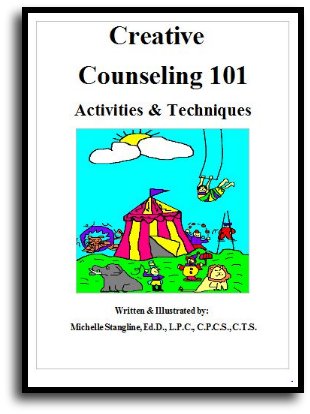
Step By Step Therapy:
Learn how to be a more Creative Therapist with the Book that started it all!
- Graduate School Counseling book used by hundreds of graduate counseling students!
- Includes full color reproducible worksheets with most activities.
- Winner of the Counselor Writer of the Year Award, 2011, Georgia Regional Award
Download Your Copy Today Only $39.95:
See Creative Counseling 101 eBook Information Here:
Get the Set
of all four
eBooks for only $98.95:
An incredible collection of how to do therapy eBooks!
A $159.80 Value,
You Save Over $60!
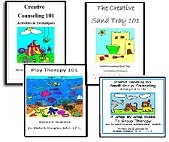
Get your complete set of the Creative Counseling 101.com eBooks by Dr. Michelle Stangline for only $98.95, that's less than $25.00 per eBook (Regular Price is $39.95 for each eBook.).
Your complete set includes:
- Creative Counseling 101
- Creative Group Counseling 101
- Creative Play Therapy 101
- Creative Sand Tray 101
For more information click the link below:
See Complete Set of eBooks For Sale Here:
New!!! "Beyond Art Therapy" 101 eBook
Over 300 pages of Beyond Art Therapy activities and techniques. Learn what I teach graduate counseling students!
See the link below for more information.
Only $39.95
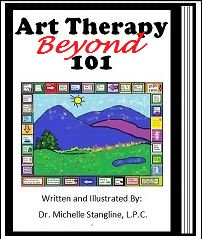
See More Invividual eBooks For Sale:
Sand Tray Therapy 101 eBook:
Learn how to do Sand Tray Therapy or enhance your skills.
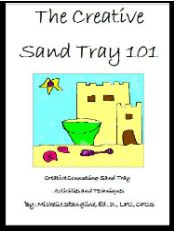
Play Therapy 101 eBook
Learn how to do play therapy or enhance your skills.
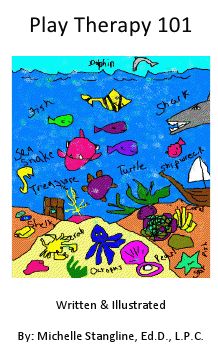
Small Group Counseling eBook For Sale:
Learn how to do creative group therapy and enhance your skills.
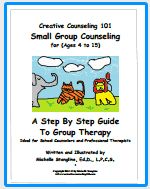
School Counselor Guidance Lesson & Social Stories eBook for sale:
Get a year's worth of school counselor guidance lessons with "Creative Warm & Fuzzy Classroom Guidance Lessons eBook". Introduce your students to the "Warm & Fuzzy Way". Click the link below for more information:
Warm & Fuzzy School Counselor Guidance Lessons eBook
